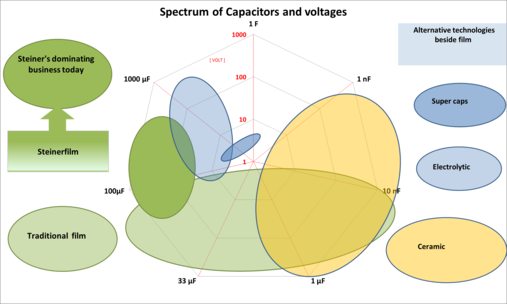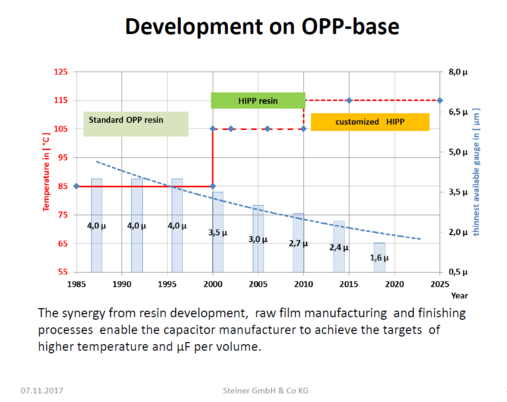Capacitor types and application fields
The capacitance C is defined as the ratio of electric charge Q to the voltage U between the electrodes:

The quotient of one coulomb per volt [ Amp sec / Volt ] represents the unit farad [ F ].
For commercial capacitors the following subunits are used, see Tab. 1.
| [ F ] : = [ Farad ] | ||
|---|---|---|
| [ mF ]– Millifarad = [10 -3 F ] | 1/1000 Farad | 0.001 F = 1000 [µF] |
| [ µF ] – Microfarad = [10 -6 F ] | 1/1000 Millifarad | 0,001 [mF ] = 1000 [nF ] |
| [ nF ] – Nanofarad = [10 -9 F ] | 1/1000 Microfarad | 0,001 [µF ] = 1000 [pF ] |
| [ pF ] – Picofarad = [10 –12 F ] | 1/1000 Nanofarad | 0,001 [nF ] |
Tab 1: Conversion of the capacitance subunits
The established types of capacitors are based on different dielectric materials and production methods. The capacitance ranges from picofarad to more than hundreds of farad. Voltage ratings can reach kilovolts.
The graph below visualizes the whole spectrum. The green area is covered by capacitors with Steinerfilm products.
Film capacitors can be found in electronic circuits for various functions and applications:
- Noise / RFI suppression
- Snubbers
- High pass and low pass filters
- Signal coupling / Decoupling
- Motor run / Start
- Resonant circuits
- Grading / balancing
- Power conditioning / power factor correction (PFC)
- Energy storage
- Pulsed power
- Voltage divider




